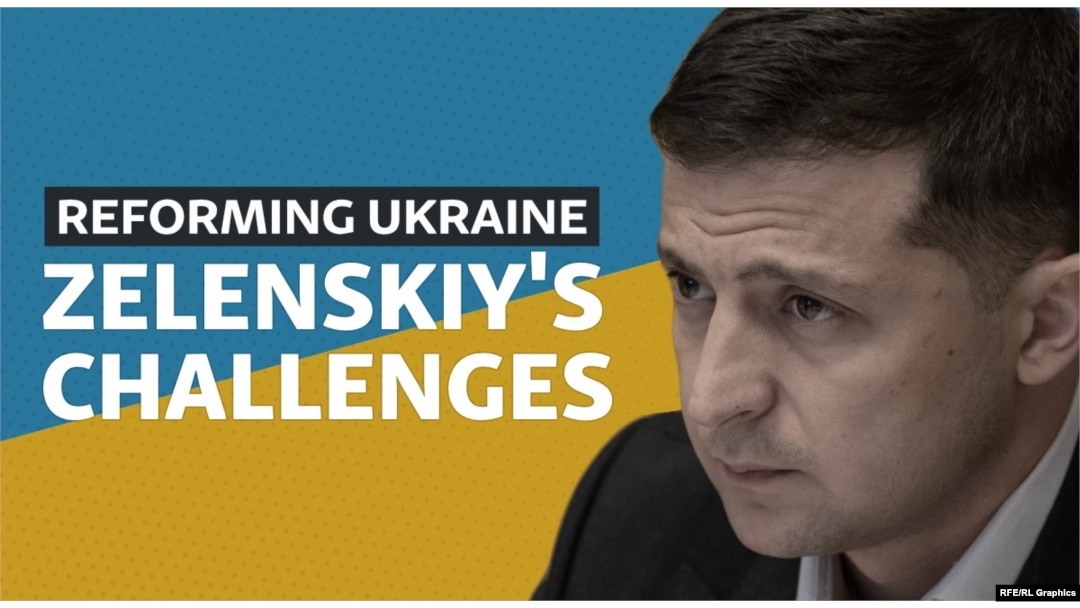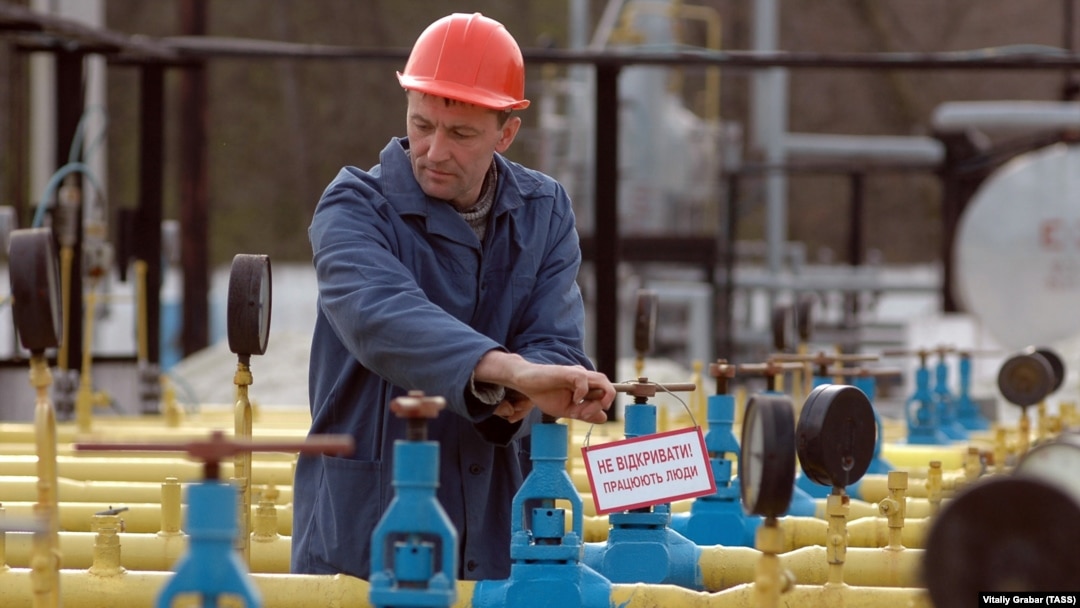After enduring two Russian gas cutoffs in the past 14 years, Ukraine could face yet another energy shortage this winter as the Kremlin seeks to circumvent its biggest western neighbor on deliveries deeper into Europe.
Given the literally chilling lessons of the past and the fact it is endowed with the third-largest proven reserves of natural gas on the continent, Ukraine might be expected to be much better prepared this time.
But a long history of corruption -- combined with excessive red tape, low domestic gas prices, and a subsequent lack of cash for investment -- have prevented Kyiv from boosting energy production to cover its needs.
That leaves it vulnerable to Moscow’s muscular energy moves at a time when ties remain close to rock bottom five years after Russia seized Crimea and fomented separatism in eastern Ukraine, helping ignite a war that has killed more than 13,000 people and keeps simmering in the Donbas.
Now, President Volodymyr Zelenskiy, a comedian and political outsider who won a landslide victory in April and has promised to root out graft and bring in foreign investment, wants to step on the reform pedal to accelerate gas output. Success on this score could bring in cash, bolster confidence in Ukraine, and blunt Moscow’s ability to use energy as a weapon against Kyiv.
But it’s a tough task and just one of several that Zelenskiy faces as he tries to translate a big mandate and strong popularity into meaningful reforms with lasting results.
Read More Of Our Special Coverage

Comic Or Commander In Chief? Reform Of Ukrainian Defense Industry Giant Tests Zelenskiy's Will
Mission: Impossible? Ukraine's New President Ventures To Reform Powerful State Spy Agency
After Years Of Stalling, Can Ukraine Finally Become Energy Self-Sufficient?
Greener Pastures For Ukrainian Farmers? Zelenskiy Plows Ahead With Land Reform
Earlier this month, Zelenskiy ordered his government to sign contracts with the winners of the 10 oil and gas tenders held this summer by December 1. Ukraine has taken as long as 18 months to sign such contracts in the past, discouraging foreign investors.
The president also told his cabinet it was “very important” to prepare more lots by the end of the year for another round of energy tenders. Known as production sharing agreements (PSAs), the contracts protect foreign investors from changes in local legislation and allow them to fight out any disputes in international courts.
In 2018, Ukraine cut the number of permits required to develop oil and gas fields by 20, speeding up the start of production by at least a year, according to industry experts. Zelenskiy’s cabinet plans to further simplify the rules governing energy exploration and development.
Zelenskiy, 41, needs to move quickly on industry reform if he wants to attract foreign energy firms during his five-year term, said Morgan Williams, president of the U.S.-Ukraine Business Council.
Major international oil companies might be willing to come back to Ukraine if they see “signs of success” in the field, he told RFE/RL.
However, exploration and drilling is time-consuming, so companies that won tenders this summer may not start production until 2021 or 2022 -- assuming the contracts are signed by December 1 and they discover profitable reserves, Williams said.
33 Years Of Reserves
Ukraine has 905 billion cubic meters (bcm) of natural-gas reserves, according to state classification -- enough to keep the nation of 44 million warm through 2047, based on current consumption levels.
The reserves could last even longer if Ukraine -- whose aging housing stock and outdated factories make it one of the least energy-efficient countries in Europe -- continues to take steps to improve energy efficiency, including raising residential prices.
And beyond the discovered reserves, there is probably much more gas that can be pumped from its fields in the Dnipro-Donets region in the east, the Carpathian region in the west, and the North Black Sea in the south.
Seismic data indicates Ukraine has another 880 bcm of prospective gas resources, a quarter of which could eventually be produced, based on the nation’s past gas-recovery rates.
But that’s all beneath the surface: Above ground, Ukraine’s gas output has remained capped at about 21 bcm since the first cutoff despite all the advances in drilling over the years. As a result, Ukraine still imports more than 10 bcm of Russian gas annually, now buying it from neighbors to the west after they receive it from Russia.
Ukraine’s current production volume is far below its potential based on global comparisons of nations’ output to their reserves. It is also far below Soviet-era numbers: Ukraine produced as much as 68 bcm of gas in the 1970s, though output declined by more than half by 1991 as the Kremlin shifted production to Siberia.
Ukraine could have halted the production stagnation years ago if it had attracted companies with the money, technology, and expertise to develop its fields, analysts said.
The country’s production problem “is not one of geology. It is more about the whole process for acquiring exploration and production licenses,” Ed Chow, a former Chevron executive and now energy analyst at the Washington-based Center for Strategic and International Studies, told RFE/RL.
An opaque bidding process over the past few decades had favored state companies and political insiders, he said.
Naftogaz & Tycoons
Despite Ukraine’s large reserve base, a small group of companies dominates gas production.
Naftogaz accounted for about 75 percent of the country’s gas output last year, with about 20 percent produced by seven companies that are owned by well-connected tycoons or former government officials, according to data by the Association of Gas Producers of Ukraine.
Over the years, Ukraine has repeatedly awarded gas licenses through noncompetitive means to insiders -- some possessing no energy industry experience. Ukraine’s Anti-Corruption Action Center estimated last year that such companies own 25 percent of all oil and gas licenses issued.
Some sit on the license for years with the hope of flipping them for a profit at a later date. The number of such licenses may be as high as 120, according to Vadym Hlamazdin, head of government relations for Naftogaz.
According to Ukrainian media reports, Golden Derrick, a company associated with friends of former President Viktor Yanukovych, was awarded more than 20 gas licenses in 2011, the year after he took office.
Local media outlets have also reported that after Yanukovych fled to Russia in the face of the pro-European, anti-corruption Maidan protests in 2014, many of those licenses ended up in the hands of Pavel Fuks, a politically connected businessman who made much of his money in real estate in Russia. Production has yet to start on the fields in question. Fuks did not respond to RFE/RL requests for comment.
Burisma Group, one of Ukraine’s fastest-growing privately owned gas producers, is controlled by Mykola Zlochevskiy, who held senior posts under Yanukovych. The company received some of its 39 licenses while Zlochevskiy was natural resources minister from 2010 to 2012.
Foreigners Leave
The situation has largely frozen foreign energy companies out over the years. And when outsiders have been able to win licenses, other problems have popped up, leaving a trail of disappointment.
Naftogaz accounted for about 75 percent of Ukraine’s gas output in 2018.
Marathon Oil, a $10 billion U.S. energy company, exited Ukraine in 2008 after it failed to conclude a government contract despite winning a tender.
Vanco, another U.S. energy company, had its license canceled following 18 months of talks after some officials didn’t like the offshore shareholding structure.
Chevron, one of the largest U.S. energy companies, pulled out of western Ukraine in 2014 due to disappointing exploration results but also because of unresolved tax issues, media reported.
Smaller foreign-owned gas companies have fared no better.
Cadogan Petroleum, a U.K.-listed company, said one of its gas-exploration licenses was not converted into a production license due to a dispute between central and regional officials over royalties.
Naftogaz says that it, too, has struggled in recent years to get new licenses because of corrupt practices, while several companies with no track record in the gas industry have been successful.
New licenses are critical for Naftogaz -- and thus for Ukraine -- because the company mainly produces gas from Soviet-era fields that are on average 80 percent depleted, Hlamazdin said. Partially as a result, Naftogaz will not meet its 2020 production target of 20 bcm.
The cabinet last year approved a resolution requiring the state to sell licenses through online auctions or tenders, said Oleksandr Parashchiy, an energy analyst at Kyiv-based Concorde Capital. The state has held several online auctions this year, as well as the first tenders since 2012.
Naftogaz teamed up with Vermilion Energy, a Canada-based company, to win two of the tenders. A pair of U.S. companies won a third.
The tenders were “a major step forward” for Ukraine’s domestic gas production and energy independence, the U.S.-Ukraine Business Council said in July.
More Changes
Other recent legislative and managerial changes are potentially setting Ukraine up for stable production growth in the coming years.
Kyiv cut taxes on all new wells by more than half starting in 2018, leading to a 25 percent jump in their number in the first year after the reduction took effect, according to the Association of Gas Producers of Ukraine.
An increase in domestic gas prices has helped turn Naftogaz from a budget blackhole a few years ago into a profitable company, finally giving it some financial firepower to reinvest in production.
There are other changes afoot at Naftogaz.
The company had long been milked by managers, directors, and tycoons, especially through procurements.
One of the more striking examples was the reported purchase of two rigs through an intermediary for $800 million that should have cost the company about $500 million.
Your browser doesn’t support HTML5
Revealed: The Palaces Of Ukraine's Oil And Gas Men
The previous managers “were interested in stealing, not developing fields,” said Oleksandr Kharchenko, managing director of the Energy Industry Research Center in Kyiv.
But new leadership is revamping how the company operates, procuring most of its goods and services through online tenders, publishing annual audited financial reports and outsourcing the latest technology.
Kharchenko said the joint venture with Vermilion amounts to a tacit recognition of the changes.
“It would not have been possible just a few years ago,” he said.
Naftogaz is now abandoning the Soviet-era practice of measuring gas business efficiency “in meterage or wells drilled” rather than profitability, according to its 2018 annual report, a practice that should’ve ended “decades ago,” said Chow.
It has started to hire the top international oil and gas service companies, such as U.S.-based Halliburton, to bring the latest drilling and 3D modeling technologies to its fields.
Fracking -- the controversial production technique that has driven a decade-long boom in U.S. energy output -- is now being deployed at Naftogaz wells for the first time, Hlamazdin said.
Separately, the company has begun inviting foreign energy-field services companies to bid for enhancement work at 13 depleted wells -- another first.
With the recent changes creating fertile ground for growth, a new reform push by Zelenskiy could make Ukraine self-sufficient by the end of the next decade, said Roman Opymakh, executive director of the gas producers’ association.


